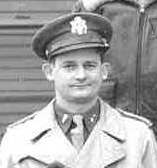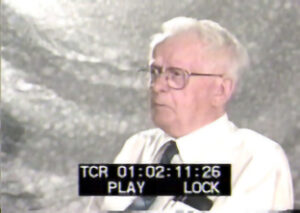The History of InfoAge Science & History Museums
Oral Histories - Oral History of Samuel Stein Interviewer: Michael Ruane
Interviewer: Michael Ruane
Date: 1998?
Place: Camp Evans – 9039
Media: NTSC Video
Summary: Mr. Irv Bauman
TAPE 2: Tape Duration: 1 hr. 15 min.
 Samuel Stine, Physicist worked 54 years at Fort Monmouth, 58 yrs. with the Army. He started as a 2nd Lt. in April 1946, OCS to 6 May 1943, out of uniform 8 April 1946, and assigned to Bldg. 2525, Field Station #2 which then had over 460 employees. Dr. Bradsfield was his Administrative Chief. He then became Chief of Staff to “Joint Meteorological Equipment For The Allies”. A specification had to be prepared for use by foreign countries. General Arnold used him as a coordinator between the Pentagon and Ft. Monmouth. He wrote specifications for the French, Italian, and British. He met General DeGaul and became his escort. He designed sensing elements for temperature, humidity, and pressure measurements. He built the first quartz crystal indicator to determine the dewpoint and temperature, accurate to 1/1000 degree.
Samuel Stine, Physicist worked 54 years at Fort Monmouth, 58 yrs. with the Army. He started as a 2nd Lt. in April 1946, OCS to 6 May 1943, out of uniform 8 April 1946, and assigned to Bldg. 2525, Field Station #2 which then had over 460 employees. Dr. Bradsfield was his Administrative Chief. He then became Chief of Staff to “Joint Meteorological Equipment For The Allies”. A specification had to be prepared for use by foreign countries. General Arnold used him as a coordinator between the Pentagon and Ft. Monmouth. He wrote specifications for the French, Italian, and British. He met General DeGaul and became his escort. He designed sensing elements for temperature, humidity, and pressure measurements. He built the first quartz crystal indicator to determine the dewpoint and temperature, accurate to 1/1000 degree.
He went to Pine Camp, NY with 25 artillery specialists for a 3-month test to determine the effect of cold on artillery items. In 1945, he was assigned to build a weather station at Shark River to include a power supply, teletype functions with 30 sensors, to report weather to the station. Then he moved from Bldg. 2525 to Evans Bldg. 36/37. Their radars would be assembled in Bldg 37 and installed in trailers with antennas 2- to 30 ft. long (known as Bedspring Radars). These were in use in Hawaii when the Japanese attacked Pearl Harbor. He then was assigned to Bldg. 39, Meteorological Branch. His work there included storm detection. In late 1942, early 1943, the first weather station was built to service Ft. Monmouth and surrounding area. His group built infrared sensors, did research on solid-state materials, tested balloons, and radiosonde. After settling in Camp Evans, half of his people quit. Bldg. 2525 became a USAF functioning location.
Mr. Stine’s group built temperature-sensitive devices, calibrated and built barometers, and shipped these along with soldiers all over the world. They distilled mercury for barometers in a building that became polluted. USAF took over this program. Stine’s group tested hundreds of thermometers for the Army. They sent up space balloons to determine the weather at 120,000 ft. Stine purchased a German telescope for $1, added a motion picture camera, and used these to determine why balloons freeze at 120,000 ft. Testing utilized a B-29 and used high altitude test chambers which simulated altitudes to 20,000 ft. His group also tested captured foreign equipment. A balloon hangar was built for these tests.
He became involved in working with a German V-2 Rocket, before it fired, to measure weather. One was maintained at Evans. He described a “Borden Tube” which had to be evacuated for use. His group builds a chemistry laboratory to generate hydrogen for balloons. They worked with potassium, calcium, sodium hydroxides, and water to produce the needed water. He then participated in Yuma Desert testing of a 6 ft. soldier with a full pack, exposed to 95 – 125 degrees F to determine what soldiers can take, exposed to heat and dust. The operation of tanks in desert environments was analyzed and breakdown found to be caused by dust. He set up 40 weather stations around Yuma and investigated how a tornado forms and how air turns and twists in and around the storm.
Mr. Stine was offered, and left Evans to become; an Assistant Professor at the University of Illinois, but was lured soon after by Monmouth to visit GE to talk to Dr. Langmuir to get his opinion on solid-state physics subjects. He became involved with seeding clouds with dry ice (Project Cirrus) and determining how thunderstorms form. Seventeen planes were used in a classified project. In Sea Girt, seeding clouds was tried. A hurricane was s ceded by a B-17, assigned to Mr: Stine, measuring all storm parts, its’ eye, and edge, temperature, humidity, and pressure. In Albuquerque, NM, clouds were seeded which produced more rainwater than a total of 3 earlier years.
Another program related to Army packaging problems with contents corrosion. Stine had to develop humidity measuring devices. For Korea Weather Stations, Stine trained 30 soldiers to read instrumentation. In Evans 80 people worked for Stine, building humidity elements of carbon. In 1961–1962, he transferred to Coles Signal Laboratory to do work in Infrared, getting involved with 32 types of IR detectors utilizing lead sulfide. A contract was placed with an outside company to develop these-To test these detectors of cadmium tellurides, he set up a laboratory in the Hexagon Building.
Page created August 2, 2002
We Need Your Help! Volunteer with Us.
Join our mission to preserve historic Camp Evans and teach the public about science and history.
Sign up to join our team of volunteers and start on your own mission today.
InfoAge Science & History Museums
2201 Marconi Road
Wall, NJ 07719
Tel: 732-280-3000
info@infoage.org
webmaster@infoage.org
